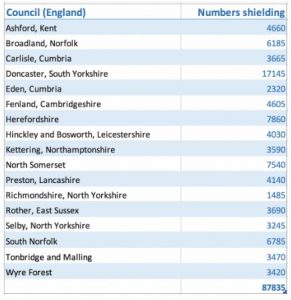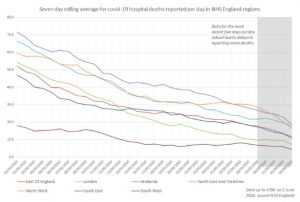As the death rate finally falls across the country, the government has rapidly switched the advice for the most vulnerable patients who have been shielding indoors, but in some areas, the rate of transmission is rising and in others, deaths are not falling as fast, so should guidance to shielding patients be more nuanced?
Just three days before the change in government advice, an analysis by the Telegraph of latest Office of National Statistics data found 18 council areas that had not yet passed the peak of weekly deaths, including Carlisle, Doncaster, North Somerset and Herefordshire.
 Lowdown researchers matched these hot spots with data from NHS digital to reveal that 87,835 patients in England shielding under government guidance, were now being told that they can venture outdoors, despite the relative differences in risk between areas.
Lowdown researchers matched these hot spots with data from NHS digital to reveal that 87,835 patients in England shielding under government guidance, were now being told that they can venture outdoors, despite the relative differences in risk between areas.
The newest research about the rate of transmission by Public Health England (PHE) and Cambridge University suggests the R rate is on the rise in some regions and is now at around 1 for the south-west and just over 1 for north-west England.
Seeing the country-wide death rate fall was one of the key triggers in the government’s decision to loosen the lockdown, but the fact that hot spots in transmission exist has led some to call for a more local response.
Anthony Costello, professor of global health and sustainable development at University College London and a former director of maternal and child health at the WHO said:
“We need to devolve power and autonomy to allow locally intelligent decisions around a coherent national strategy”
The government has made some moves in this direction. Matt Hancock told viewers of the Andrew Marr programme how the government had acted in response to a spike in cases in Weston Super Mare: “We had close the hospital to new admissions”.
Despite this localised response the government still have a blanket policy to shielding, offering the same guidance to across all areas
As the new guidance emerged from the UK government, leaders in Northern Ireland and Scotland took a different view as their shielding advice did not change.
New data is also now making regional differences are more apparent. Weekly hospital deaths are highest in the North West. In all regions the rate of deaths is still falling with the exception of London and the South west where the number of deaths in hospitals is stable. The rate of deaths in care homes is also falling.

—- Graph of death rates: —-
More at risk
Researchers at university college London have warned that the number of vulnerable people may be higher than 2.5 million currently shielding. They have published a study in Lancet that concludes that eight million people that are vulnerable because of pre existing health conditions and should be exempted from moves to get people back to work, warning that lifting the restrictions too early could lift the death toll to 73,000.
Senior author, Professor Harry Hemingway, (UCL Institute of Health Informatics and Research Director of Health Data Research UK), said:
“Our findings emphasise the importance of delivering consistent preventive interventions to people with a wide range of diseases.”
Dear Reader,
If you like our content please support our campaigning journalism to protect health care for all.
Our goal is to inform people, hold our politicians to account and help to build change through evidence based ideas.
Everyone should have access to comprehensive healthcare, but our NHS needs support. You can help us to continue to counter bad policy, battle neglect of the NHS and correct dangerous mis-infomation.
Supporters of the NHS are crucial in sustaining our health service and with your help we will be able to engage more people in securing its future.
Please donate to help support our campaigning NHS research and journalism.


